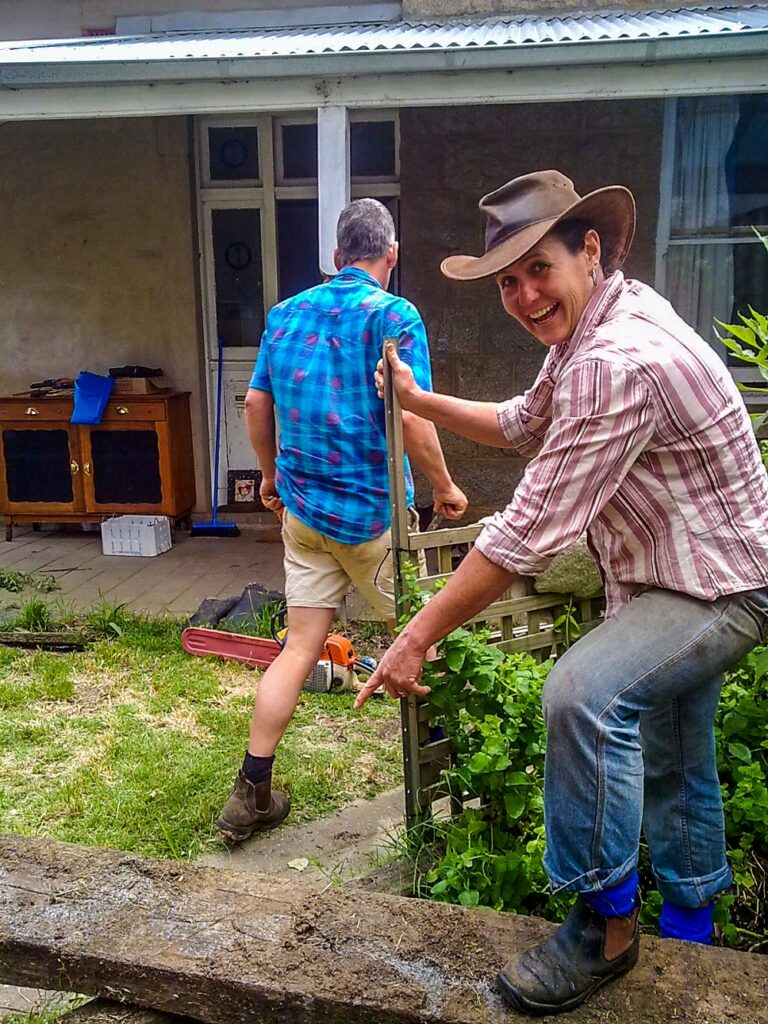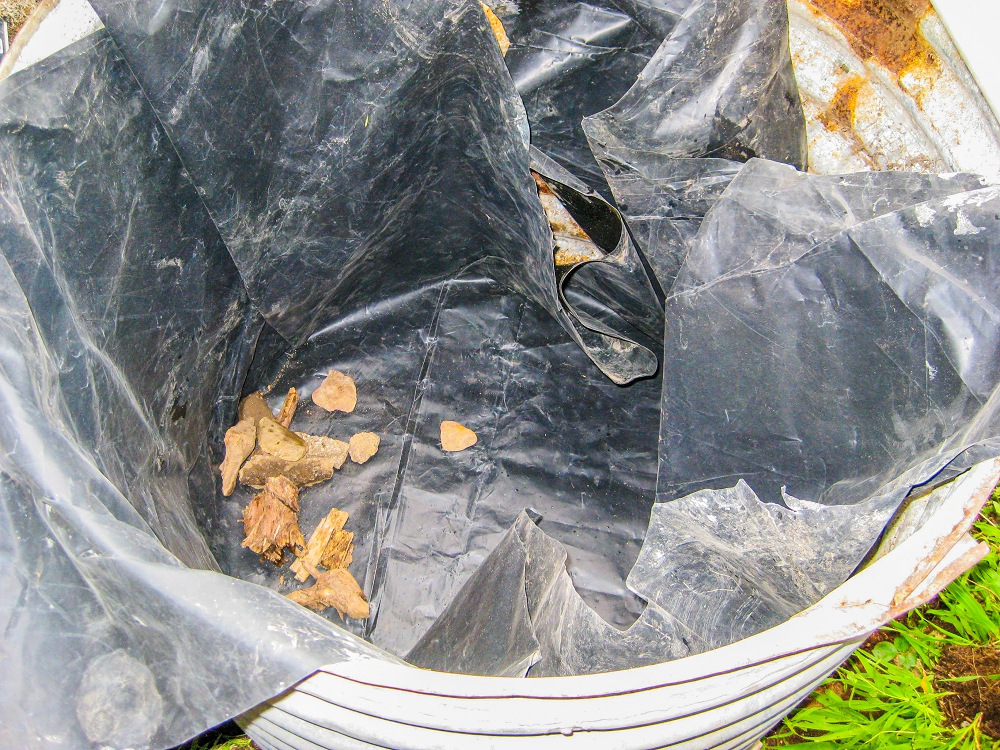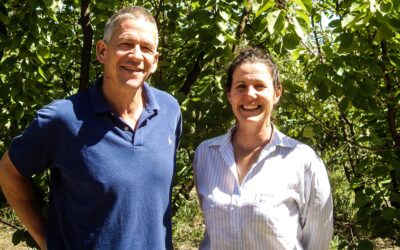Estimated reading time: 11 minutes
Wicking beds are an innovative and water-saving way to garden. They’re a fabulous choice for fruit trees in some situations and a popular way to grow vegetables.
While wicking beds are not the right choice for all fruit trees they are a wonderful option for growing trees in pots. And if you’re a fruit grower, you probably also want to grow your own vegies.
So let’s talk about wicking beds.
When we first started farming, we didn’t have a gardener’s elbow between us, let alone a green thumb.
But we had a great teacher in Katie’s dad. We were envious of the ease with which he seemed to be able to produce enough veggies to feed the family, plus a surplus.
Some people just seem to have a knack for knowing when and how to do things, but at the beginning, we definitely didn’t feel like that.
We imagine it’s exactly how people who are just starting to learn how to grow fruit feel. 😊

Permaculture and wicking beds
Common sense says growing vegetables can’t be all that difficult, so we did a permaculture course to start learning what to do.
It definitely helped! We’ve learned a few tricks and techniques that make vegie growing much easier. One of them was learning about wicking beds. They’re a fantastic solution for problematic parts of your garden. For us, that was next to a 150-year-old cypress tree.
We love the tree, but the roots are completely pervasive. Pretty much nothing will grow underneath it. That would be fine if the it were out in a paddock. But it’s smack-bang next to the house.
In permaculture terms, that’s called Zone 1. The area closest to your kitchen and the path you use each day to enter the house. The perfect place to grow vegetables and herbs, in other words.

How do wicking beds work?
The principle is that the bed is lined with plastic to create a closed system. Find the instructions for how to build one here.
Water is delivered to the bottom of the bed via an upright pipe. The plants ‘wick’ the water up from the bottom, so no water is lost to dehydration.

To make sure the wicking principle works, the beds must be level – as this spirit level shows (well, actually it shows that it’s not quite level yet, but you get the idea).
It’s a great trick for a dry summer landscape. It’s also the perfect solution to growing other plants beneath massive existing trees.
Keeping wicking beds fertile
One of the problems with wicking beds is that they’re not connected to the earth. That means it’s harder for the natural fertility cycle to operate. Worms for example can’t move in and out of the beds.
That means it’s super important to add nutrition. We generally use worm castings from the worm farm and compost. We occasionally give the beds a boost with some cow manure.
Weeds and leftover plants from the garden get piled up near the chook shed at the end of each season. Then we clean out the chook shed and start the next compost pile. That way all the nutrients are returned to the soil.
Gardening is just so cyclical!
What to plant
Wicking beds perfectly suit herbs and vegetables. Ours are in a lovely sheltered spot, so over the years, we’ve used them to grow masses of summer vegies like tomatoes, sweet corn, pak choi, silver beet, kale, celery, coriander, and chillies.
In winter they’ve supplied us with cauliflower, broccoli, broccolini, brussels sprouts, cabbage, and celery.
We use lots of herbs, so our beds include things like Vietnamese mint, lemon balm, tarragon, chocolate mint, ordinary mint, marjoram, and thyme. And then there are the perennial vegetables like asparagus, rocket, and horseradish.
Can you plant fruit trees in wicking beds?
At the start of this article, we said wicking beds are a good option for some, but not all fruit trees. It all depends on the bed and the tree.
Most people think of wicking beds as relatively shallow garden beds. But if you build a deeper wicking bed, and match it to the right type of tree, it can definitely work.
In fact, it’s one great way to grow fruit trees in pots.

We’ve successfully converted an old water tank into a wicking bed. It’s been hosting a thriving Makrut Lime tree for many years now.
What fruit trees in wicking beds need
If you want to grow a fruit tree in a wicking bed, firstly consider the dimensions of the bed. Make it as deep as possible to accommodate the tree’s root system.
Next, choose your tree wisely. Trees on dwarfing rootstock are best, or trees (like our little lime tree) that will thrive even when constricted by the size of its pot.
And lastly, keep a close eye on nutrition. When you’re growing a tree that’s not connected to the earth, you need to think like the earth and make sure all the tree’s needs are supplied.
If you look after them carefully, a fruit tree in a wicking bed can live a long, happy, and fruitful life.

Related Articles
Preparing your fruit trees for fire season
Protect your precious fruit trees and garden from fire risk with some pre-summer planning and taking a few key actions.
Grow strawberries successfully with the right care
Getting a good yield of sweet strawberries starts with feeding and watering the plants regularly, and protecting them from pests and diseases.
Welcome to our organic farm
Welcome to our organic farm in central Victoria where we empower people to grow their own organic, nutrient-dense food.








Had rhubarb was growing in wicking bed and had sprouted more heads . Added some dry mulched horse manure and it died off adter amonth. Every rhubarb was gone. The horse manure was old and not new. There was water in the wicking bed. Could the water have gone off or maybe the rhubarb did`nt like the horse manure. Would apprciate a reply if you can offer any suggestions before i purchase some more rhubarb.
I don’t know about where you live; but, in a lot of areas, people that grow hay use persistent herbicides that survive digestion and poison the manure.
A lot of city parks, etc. have lost trees when they used manure to fertilize them.